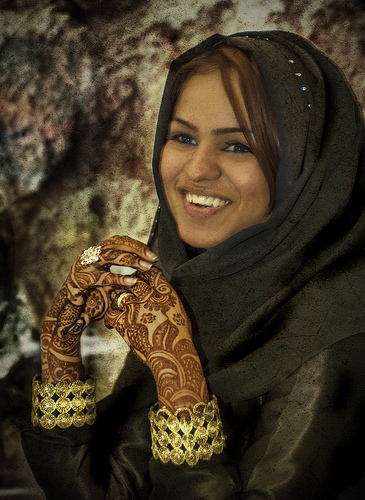
DOHA, Qatar — On the day before his college graduation here, Thamer Al-Kuwari wore the white robe and headdress that are customary for men in his native Qatar. But on his finger, he wore something special: an Aggie Ring, the traditional accessory of a proud Texas A&M University alumnus, which he was about to become.
Al-Kuwari’s enthusiasm for Texas A&M may, at first blush, seem strong for someone who spent a mere four months studying in College Station. “Ever since I joined the Aggie family,” he said, “I’ve loved it with every part of my heart.”
Such is the extent to which students at Texas A&M University at Qatar consider themselves connected to the main A&M campus, more than 8,000 miles away. The Class of 2012 in Qatar boasted 87 students from 23 countries. They were required to complete the same coursework that they would at the main campus, including lessons in American and Texas history and government. The courses, taught in English, were co-ed, common at most Texas colleges, but a whole new experience for many in their first year.
As of 2011, A&M’s Qatar campus had nearly 140 active research projects totaling more than $96 million. In terms of producing graduates and securing research financing, A&M is now the highest-performing university involved in Education City, a 2,500-acre site on the edge of Doha that is dedicated to elite higher education. A&M officials said their involvement puts the university at the forefront of international education.
R. Bowen Loftin, A&M’s president, said the university is involved because of the students’ ability to represent Aggies internationally. “Ten years from now, they are going to be ministers of state and CEOs of major companies, the major drivers of that part of the world, not just Qatar,” he said. “This is Texas A&M’s contribution to that leadership development.”
Enrollment has ballooned at A&M’s Qatar campus, to 524 in spring 2012 from 29 in fall 2003, when it debuted. The first graduating class, in December 2007, consisted of just two Qatari women. Following this year’s record-breaking number of graduates, administrators expect enrollment to begin to plateau.
“This is kind of the top of the mountain that we’ve reached,” Loftin said.
Education City is the hallmark project of the Qatar Foundation, a nonprofit organization established in 1995 by the country’s ruling emir, Sheikh Hamad bin Khalifa Al Thani, and chaired by his second wife, Sheikha Mozah bint Nasser al-Missned, who is widely recognized as the driving force behind efforts to convert the gas-rich nation into a knowledge-based society.
Six American universities — A&M, Georgetown, Carnegie Mellon, Northwestern, Virginia Commonwealth and Weill Cornell Medical College — have a presence here. The invitation to open a branch specializing in engineering degrees — the only kind A&M currently offers in Qatar — was first extended to A&M’s chief rival, the University of Texas, but UT declined to participate.
Because A&M is a public institution, no financing or tuition revenue from Texas can be used toward the effort in Qatar. All expenses, including the tab for the $150 million marble building that houses the A&M campus, are paid for by the Qatar Foundation, which has abundant resources.
Unlike some American universities that floundered after they came to the region and had to pull up stakes — like Michigan State University and George Mason University in the United Arab Emirates — A&M does not have to generate the revenue to support itself.
“Not many countries have that level of resource, and even if they did, they might not want to invest it, as Qatar Foundation has, in education,” said Mark Weichold, the dean and chief executive of A&M’s Qatar campus.
Qatar’s decision to pour resources into brand-name universities has occasionally met with skepticism in the region. In 2009, McMaster University professor Virginia Aksan, who was then the president of the Middle East Studies Association, described Education City as “the marketing of an imagined education” and warned of the proliferation of “profit-motive teaching environments” abroad.
“Texas A&M is not in this for making a profit, but we can’t lose anything either,” Weichold said.
The university and its officials are contractually barred from revealing the specifics of the exchange between the Qatar Foundation and Texas A&M.
Karan Watson, A&M’s provost and executive vice president for academic affairs, acknowledged that per-student financing in Qatar is significantly higher than in College Station. “They are good partners,” she said of the foundation, “and on top of being sure they have covered all the expenses, they give us a little bit on top of that every year.”
She conceded that, while not a major driver, the “little bit on top” is more than the $4.5 million profit that Houston Community College projects it will make over five years as a result of a deal with Qatar’s Supreme Education Council to launch the country’s first community college.
In College Station, that money helps the colleges involved in the Qatar campus — liberal arts, science and engineering — and it also helps support study abroad programs and other strategic investments, like start-up financing for hiring faculty members.
Through the arrangement, A&M also gains access to one of the world’s most plentiful sources of research money. Qatar has committed to spending 2.8 percent of its annual gross domestic product— about $1.5 billion — on research financing, primarily distributed by the Qatar National Research Fund, which allows up to 35 percent of a financed project to be conducted outside the country.
It took time to get A&M’s research started in a country that did not previously have a strong culture of academic research. The university did not have its own facilities until 2007. Professors in Qatar — several of whom came from the main campus, though A&M quickly realized it would have to hire permanent Doha faculty in order to sustain the endeavor — noted the extra time required to import necessary materials and set up for their labs, which are subject to Texas’ rules and regulations as well as Qatar’s.
“There’s no routine here,” said Eyad Masad, the assistant dean for research and graduate studies on A&M’s Qatar campus. “Everything is new. Every company you deal with is a new mindset, a new contract, new expectations. In Texas, things have already been developed.”
Other established academic practices have had be reworked similarly. The Qatar Foundation was not comfortable with the notion of tenure, so it developed a rolling contract system, in which a professor’s guaranteed length of employment could increase over time.
With the initial 10-year agreement quickly coming to a close, officials at A&M said the benefits to both the Aggies and the Qataris have exceeded expectations, and they have already begun to plan for the next 10 years.
New programs are in the works, and a master’s program in chemical engineering was recently added, one of Education City’s few graduate programs.
Now that Al-Kuwari is graduating from A&M, he plans to work at Qatar’s Ministry of the Interior. He said he would always be a proud member of the global Aggie community.
“From the first day, I wanted to be a part of it,” he said. “We live as one person. We all have the same values. We all share the same things.”
Texas Tribune donors or members may be quoted or mentioned in our stories, or may be the subject of them. For a complete list of contributors, click here.



 -0.17
-0.17 +0.33
+0.33 -6.43
-6.43 -0.09
-0.09 +0.01
+0.01 -0.02
-0.02 -0.02
-0.02 -0.41
-0.41 +0.36
+0.36 +0.07
+0.07 +0.04
+0.04 +5.07
+5.07 +0.06
+0.06 +0.36
+0.36 0.00
0.00 -0.27
-0.27 -0.16
-0.16 +0.46
+0.46 -1.54
-1.54 +5.35
+5.35
Leave a Reply